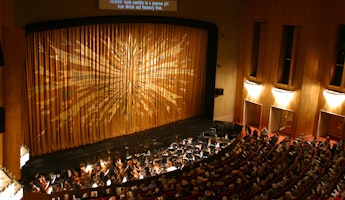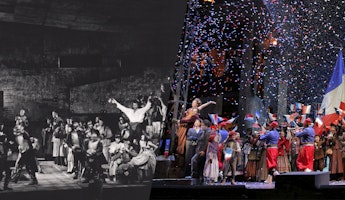Blog
September 5, 2024
Puccini, Melodrama and the Ubiquitous Feminine
Chi ha vissuto per amore, per amore si morì.
(Who has lived for love, dies for love.)
—Giacomo Puccini/Giuseppe Adami (Il Tabarro)
Madame Butterfly is the last of three nearly perfect operas from what might be termed Giacomo Puccini’s middle period, a musical, theatrical, dramatic and psychological high point in the composer's output. It is a melodrama that ends tragically, the result of the total contradiction of how the protagonists—Cio-Cio-San, a late 19th-century geisha, and Benjamin Franklin Pinkerton, an officer in the service of the U.S. Navy—view their (arranged) marriage. She takes it very seriously, a lifelong love. He does not. He looks upon it as a passing amusement during his relatively short stay in Japan. That clash is the crux of the tragedy, which plays out in the single intimate setting of a house on a hill overlooking the Japanese port of Nagasaki.
Cio-Cio-San is one of the most sophisticated character studies in Puccini's output. She is perhaps the only of his heroines who truly fulfills a part of the classical model, in that her death is not the result of random chance or accidental circumstances.
To the ancient Greeks, tragedy implied, amongst other elements, defiance of the gods (hubris), falling from a great height, or a fatal flaw. The height from which Cio-Cio-San falls is not that of temporal power, but a metaphoric one, that of a supremely virtuous humanity. If she has a flaw, it is credulity or blind faith. She sees only one course of action when faced with a choice amongst abandonment, returning to her previous life, or marrying someone she does not love. She sees jigai, a ritual suicide and honorable death, as the only dignified alternative.
Before her marriage, she had been a geisha, an entertainer using her musical, dancing and conversational skills to entertain guests at private events. To become a geisha is to follow a highly honorable profession, one that requires years of rigorous training. To be very clear, geishas are not sex workers.
It is hard to name another composer whose entire creative force so rarely deviated from a single focal point. Puccini’s fascination with “Women in Love” was the alpha and omega of his life’s work. And not only his operas: his life, too, was ruled by his attraction and absorption with women and eroticism.
As a composer, he embraced the theater and eschewed absolute music. As a dramatist, he chose the “sufferings of little souls” (his words) over the grandiose stories of kings and queens, potentates, czars and grand inquisitors, the gods of ancient Greece and Rome. He does not write about the transcendent. He wrote about one theme: love, erotic/romantic desperation and death. As a man, he was melancholic by character and pessimistic by philosophy.
His inexhaustible genius repeatedly dressed up his obsession with “Women in Love” in a garb foreign to his audiences, creating an apparent distance from the immediacy of his fixation. In an apparent contradiction to the contemporary goals of verismo opera, which concentrated on everyday people and situations (meant to be slices of life recognizable by his public). these admittedly ordinary individuals are always, oddly enough, far removed by Puccini from contemporary Italian life.
“The Woman” is his protagonist—the love, passion, devotion, desire, jealousy, nostalgia, yearning and disappointment she feels and inspires. He writes in the third person, sympathizing with her and her tragedy. Puccini himself, however, is the secondary protagonist, infusing every drama with his own psychological projections. Digging below the surface, plumbing the depths, seeking the hidden source, we can hear and feel his own, often turbulent, inner self.
Love and life, lived and lost together, are the elements of melodrama. This common theme is not his nor Italian opera's exclusive property. It had been played out through the entire European nineteenth century. From Schubert and Schumann lieder through Wagnerian music drama, from the heights of the romantic melodramas of Rossini and Verdi through the femme fatale of Bizet, Saint-Saëns and Massenet, linking the past and the present, it has found its way through every genre. But Puccini filters and distills it in a very personal way, almost exclusively through the agency of a woman's personal tragedy.
Of his twelve operas, six are named for their female protagonists (Manon Lescaut, Tosca, Madame Butterfly, La Fanciulla del West, Suor Angelica, Turandot); two have titles which refer to one or more women (Le Villi, La Rondine). The title of La Bohème derives from the novel La Vie de Bohème, but nevertheless its central character is a woman. Only two of Puccini’s operas are named for men (Edgar, Gianni Schicchi) and one for an object (Il Tabarro). The subject matter is always love and death.
For those writers who might adopt a psychoanalytic point of view, Puccini, the man, is enmeshed in a complex web of obsession, dependence and, perhaps unconscious, hostility. Ambivalent feelings of love and hate, tenderness and cruelty directed towards his female protagonists, are dramatized in the arena of his operas. These conflicts are played out repeatedly, but never resolved. That his psyche and art were so inspired and attracted by "The Woman" should come as no surprise. He had grown up in a predominantly feminine environment, strongly attached to his mother, who was widowed when young Giacomo was five years old. He had five sisters and only one younger brother.
Women have always been central to the work of male artists over the centuries. But there is a collection of factors, a syndrome, peculiar and specific to the dynamics of Puccini’s melodramas. Each soprano wins our sympathy with her beauty (inner, outer or both) and her ardent love. And each one characteristically suffers, at the hands of men, society or fate. The perpetrators vary in character, but not in their destructive and often villainous effect.
The results of Pinkerton’s actions are catastrophic. He is essentially a narcissist and reflects a sense of entitlement. He is a superficial person, guilty of a certain arrogance and even moral crimes including bigamy. (This story precedes William Lederer and Eugene Burdick’s famous American novel The Ugly American and the Vietnam War, by over half a century.)
Some other male perpetrators are Scarpia, a Roman chief of police; Jack Rance, a sheriff of the Wild West; and Michele, a Parisian stevedore and a jealous husband. Death almost always triumphs over love, reversed only by Minnie, the Girl of the Golden West (after pain and anguish), La Rondine's Magda, Gianni Schicchi 's daughter Lauretta in Puccini's only comedy, and Turandot (though the enslaved Tartar woman Liù, the composer’s last sympathetic heroine, sacrifices herself at the altar of love in that opera).
Puccini paradoxically loves each one of his heroines with great tenderness and deep empathy, justifying, or at least rationalizing, whatever faults they may have. The crueler their misfortunes, the more intensely Puccini expresses their suffering in his music. None of this suggests that Puccini's philosophy would justify women's maltreatment, nor that he advocated for it.
In an ultimate irony, death claimed the composer before he completed the “happy” ending to Turandot. In this final fairy tale, his composition was interrupted and left unfinished after Liù, his last beloved tragic victim, dies by her own hand. This gentle and devoted slave girl is fully Puccini’s creation; she does not exist in the original Gozzi drama, and only two fully distinct characters can even possibly have contributed to her presence in the opera. Nor does she really have any function in furthering the plot. Her inclusion says more about Puccini’s need for a lyric, suffering, victimized sentimental heroine who dies for love in an opera whose icy protagonist is anything but sentimental.
The likelihood is that the suicide of Dora Manfredi, the teenaged servant in the Puccini household who was falsely accused by the composer’s wife of being his mistress, was the creative impetus for Liù. It is hypothesized that Puccini memorialized Manfredi, and expiated his own guilt, by creating this gentle character, so reminiscent of Cio-Cio-San. Whatever the reason, her presence in the opera provides the distinctive characteristics of the Puccinian syndrome of the lyric victim. Is it significant that Puccini did not (or could not) finish the opera after her death? Even had he completed the opera, it is questionable as to whether he could have avoided some sense of anti-climax that is certainly the case with Turandot in its ultimate form.
His operas stem from drama, and his music always serves that end. Puccini chose (“was chosen,” in his words) to write exclusively for the theater. He wrote, “I am a man of the theater… I see the characters, the colors and [their] gestures. If, alone at home, I don’t succeed in seeing the stage planted in front of me, I don’t write, I can’t write a note.”
The emotional underpinnings of his entire output have clear and consistent characteristics. The repetitive and obsessive turbulence of melancholy, desire, psychological cruelty and romantic catastrophe is the soul of Puccini's theater. The “psychic” similarity is masked by Puccini’s compositional and theatrical genius, which is to be found in the inspired and varied portrayal of subjects foreign and distant from his public. Significantly, he was, in contrast to Verdi, an internationalist in his absorption of foreign influences into his music. He seemed to detach the immediacy of his dramas by placing them at a temporal and geographic distance from his audiences. Was he also disguising a virtual sameness of the psychological foundations of his muse?
In a partial contradiction to the spirit of the time, in which the verismo movement encouraged exploring the lives of common people in art (Puccini’s “little souls”), he set not a single drama in contemporary Italy, choosing in its stead the Black Forest, Flanders, Paris (four times), Italy of centuries past (thrice: Florence in 1299, an unidentified 17th-century convent, and Rome in 1800), the American Wild West, Japan and Ancient China.
Madame Butterfly and Turandot provided him with the musical scenery to explore his curiosity and admittedly Eurocentric understanding of Asian music and harmony.
It must be remembered that the Japan of Madame Butterfly, the ancient China of Turandot, as well as the America of La Fanciulla del West, are all written through the eyes and ears of an Italian European, for a predominantly Italian-European public. His natural habitat is the Italian musical syntax of his heritage, now dressing up his new opera and enriching it with a degree of Asian musical elements, thus creating a complex mix of Eastern/Western influences, the revolutionary effects of Wagnerian reforms, and more than an incidental dose of Debussy (particularly after the recent success of Pelléas et Mélisande). We, the inheritors of this extraordinary music, have benefited from Puccini's cosmopolitan personality and his openness to everything going on in the musical world of his time.
As the nineteenth century yielded to the twentieth, Europe saw the gradual decline of the social and political order, the dissolution of the Belle Époque and the convulsions of the First World War. Puccini, the artist, seemed to ignore it all. He continued to live and write about the power of passion and resulting personal tragedies in an age that was gradually turning away from those themes. He embodied the Italian melodrama and was its preeminent and last great advocate. It virtually passed from the operatic stage with him. Had the bar been raised too high to be equaled? Will the genre of operatic melodrama exhaust itself in the next twenty years of Puccini's lifetime. Had it lived its life and perished from its love?
At Cio-Cio-San's death, Puccini leaves the public in a state of shock with a shattering dissonance as chilling today as it was in 1904. The opera (predating Richard Strauss' Salome and Elektra) concludes unconventionally with that dissonance, which is neither earthbound, grounded harmonically, nor redemptive. It is a disturbing gesture that leaves the listener dangling perilously in the air.
Does it say something about Puccini, who will live twenty more years with his own unresolved inner psyche in a state of permanent turmoil? To paraphrase the citation from Il Tabarro, quoted at the beginning of this article: had Puccini the man, and the artist, lived, and died, for love?
© 2024, James Conlon








/03-cosi/_dsc0996_pr.jpg?format=auto&fit=crop&w=345&h=200&auto=format)

















